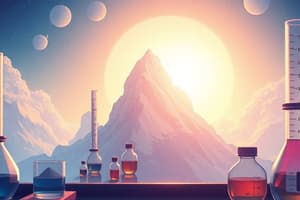Podcast
Questions and Answers
Which of the following statements about ionic compounds is true?
Which of the following statements about ionic compounds is true?
- Ionic compounds have solely covalent bonds.
- Ionic compounds do not dissolve in water.
- Ionic compounds only form in solid state.
- Ionic compounds have a higher boiling point than covalent compounds. (correct)
Electronegativity measures an atom's ability to attract electrons in a chemical bond.
Electronegativity measures an atom's ability to attract electrons in a chemical bond.
True (A)
What is the mass number of an element if it has 6 protons and 8 neutrons?
What is the mass number of an element if it has 6 protons and 8 neutrons?
14
The ______ is the central part of an atom that contains protons and neutrons.
The ______ is the central part of an atom that contains protons and neutrons.
Match the following terms with their correct descriptions:
Match the following terms with their correct descriptions:
Flashcards
Density
Density
The amount of matter in a given volume. It is measured in grams per cubic centimeter (g/cm³).
Dissolving of ionic compounds
Dissolving of ionic compounds
The ability of an ionic compound to dissolve in water. This happens because the water molecules pull the ions apart, breaking the ionic bonds.
Electronegativity
Electronegativity
A measure of an atom's ability to attract electrons in a chemical bond. It indicates how strongly an atom pulls electrons towards itself.
Atomic Number
Atomic Number
Signup and view all the flashcards
Bohr-Rutherford Diagram
Bohr-Rutherford Diagram
Signup and view all the flashcards
Study Notes
Density, Mass, and Volume Calculations
- Density is mass per unit volume.
- Formula: Density = Mass / Volume
- Units: g/cm³ or kg/m³
- Calculations involve determining density using known mass and volume or calculating mass or volume given density and one other value.
Ionic Compound Dissolution in Water
- Ionic compounds dissolve in water due to the attraction between water molecules (polar) and the ions (positive and negative) in the compound.
- Water molecules surround and separate the ions, breaking the ionic bonds.
- Polarity of water is crucial for dissolving ionic compounds.
Electronegativity
- Electronegativity is the ability of an atom to attract shared electrons in a chemical bond.
- Electronegativity values help predict the type of bond formed (e.g., ionic or covalent) between atoms based on the difference in electronegativity values.
- Values increase across periods and decrease down groups in the periodic table.
Atomic Structure: Protons, Neutrons, Electrons, Atomic Number, and Mass Number
- Protons: Positively charged particles found in the nucleus.
- Neutrons: Neutral particles found in the nucleus.
- Electrons: Negatively charged particles orbiting the nucleus.
- Atomic number: Number of protons in an atom.
- Mass number: Sum of protons and neutrons in an atom.
- Atomic number determines the element's identity. Mass number varies between isotopes of an element.
Bohr-Rutherford Diagrams
- Diagrams depicting the arrangement of electrons in an atom's shells/energy levels and the nucleus position (protons and neutrons).
- Visual representation of atomic structure.
- Shows the number of protons, neutrons, and the electron distribution around the nucleus.
- Each shell/energy level can hold a certain maximum number of electrons.
Studying That Suits You
Use AI to generate personalized quizzes and flashcards to suit your learning preferences.




